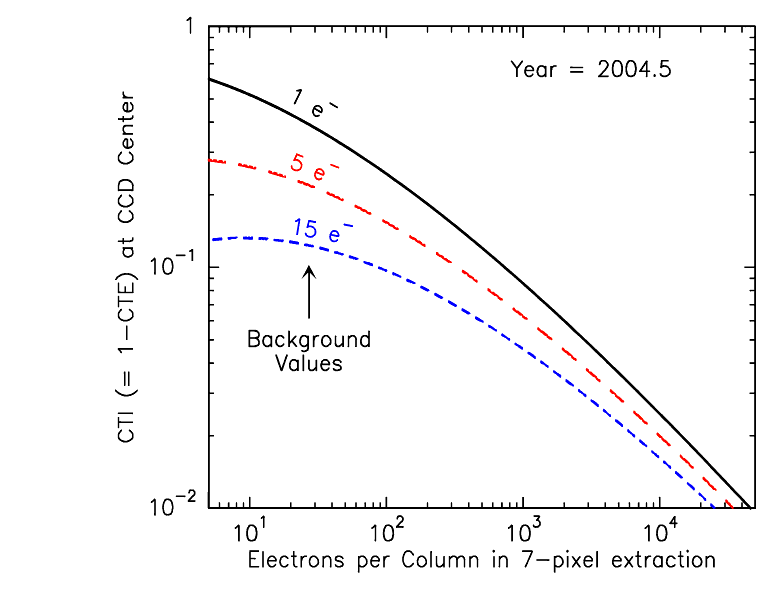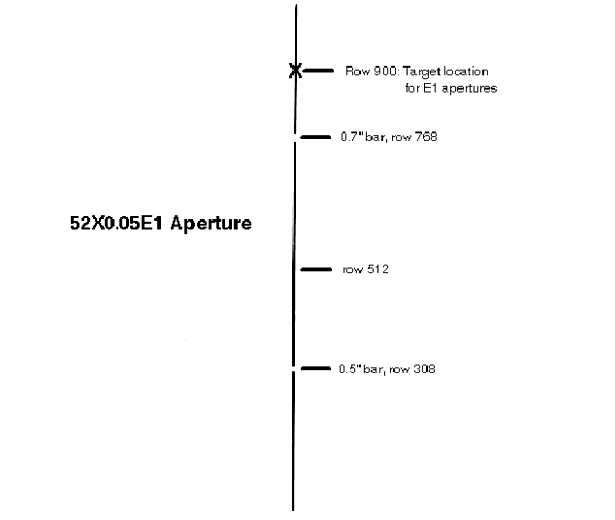
For standard applications keep the accumulated electrons pixel-1 per exposure below 120,000 at CCDGAIN=4 (determined by the CCD full well), and below 30,000 at CCDGAIN=1 (determined by gain amplifier saturation).



There are no hard bright-object limits to worry about for CCD observations, because the CCD cannot be damaged by observations of bright sources. However, the CCD pixels do saturate at high accumulated count levels, due to the finite depth of the CCD full well. The CCD saturates at ~144,000 electrons pixel-1 in most of the effective area of the chip; however, over the outermost (serial=x) portion the CCD saturates at 120,000 electrons pixel-1. The variation of the CCD full well over the chip occurs because of nonuniformity in the process of boron implantation, which creates the potential wells in this type of CCD. Accumulations up to the full well limit can be observed only in the CCDGAIN=4 setting, as the gain amplifier already saturates at ~33,000 electrons pixel-1 in the CCDGAIN=1 setting (see Section 7.1.10).
Saturation imposes a limit on the product of the count rate and the integration time. Keep the total counts in the pixels of interest below the saturation level, either by keeping the exposure time short enough that the limit is not violated in any single integration or by choosing a more appropriate configuration. You can allow saturation to occur in regions of the image over which you do not wish to extract information (e.g., you can allow a star or single emission line to saturate if you are interested in other features). Remember, however, that once the CCD well is over full, charge will bleed along the columns of the CCD so that neighboring pixels (along the slit for spectroscopic observations) will also be affected. Saturation cannot be corrected in post-observation data processing.
An interesting exception to this is described in Gilliland, Goudfrooij & Kimble, 1999, PASP, 111, 1009-for CCDGAIN=4 the response remains linear up to, and even far beyond saturation if one integrates over the pixels receiving the charge bleed. Because the bleeding is perpendicular to the dispersion direction, for point sources such saturation does not compromise spectral purity. Signal to noise values of ~10,000 have been demonstrated for saturated data-see STIS ISR 99-05 for a time series application.
In Section 6.2, we explained how to determine the peak counts sec-1 pixel-1 expected for your observation. In Chapter 13 for each spectroscopic mode and in Chapter 14 for each imaging mode, we provide plots of exposure time to fill the CCD well versus source flux for each STIS configuration. Lastly, exposure time calculators are available on the STScI STIS web site. Use one of these sources to ensure that your observations will not saturate sources of interest.
The minimum CCD exposure time is 0.1 seconds, providing a true limit to the brightest source that can be observed without saturating.
The STIS CCD camera features a high-speed shutter that eliminates the need for a shutter illumination correction, even at the shortest commandable exposure time of 0.1 seconds. The only two minor drawbacks of using this shortest exposure time are the following: (i) a non-reproducible large-scale variation in intensity of a very low amplitude (~0.2%) which is due to a slight non-uniformity of the shutter speed, and (ii) a mean count rate which is ~3% lower than those of longer exposures, which is due to an inaccuracy of the shutter timing at this setting. These minor effects occur only for the shortest exposure times, and disappear completely for exposure times of 0.3 seconds and longer.
All CCD exposures are affected by cosmic rays. The rate of cosmic ray hits in orbit is very high compared to ground-based observations. The current rate at which pixels are affected by cosmic-ray hits is 30.0 (± 3.7) pixels per second for the STIS CCD. To allow removal of cosmic rays in post-observation data processing we recommend that whenever possible, given signal-to-noise constraints, you take two or more exposures in any given CCD configuration (see also Section 11.2.2). The greater the number of independent exposures, the more robust is the removal of cosmic rays and for very long integrations it is convenient to split the exposure into more than two separate images to avoid coincident cosmic-ray hits. As an example, for two 1200 sec exposures, about 1250 CCD pixels will be hit in both images and will therefore be unrecoverable. Moreover, since cosmic ray hits typically affect ~5 pixels per event, these pixels will not be independently placed, but rather will frequently be adjacent to other unrecoverable pixels. In general, we recommend that individual exposures should not exceed ~1000 sec duration to avoid excessive amounts of uncorrectable cosmic rays in the images. However, observers must balance the benefit of removing cosmic rays against the loss in signal-to-noise that results from the splitting of exposures when in the read-noise-limited regime.
In observations of faint sources, particularly for dispersed light exposures, the intrinsic count rates can be very low. The exposure time needed to reach a break-even between the read-out noise and the Poisson noise per pixel associated with the minimal sky background is ~15 minutes for imaging in 50CCD mode, and ~36 minutes for slitless spectroscopy with G750L. With a dark current of ~0.004 e- sec-1 it takes ~80 minutes of integration for the Poisson statistics on the detector background to equal the read noise. Therefore, repeated short exposures of faint sources can significantly increase the total noise from added readouts. Selecting the correct number and length of repeated integrations requires a consideration of the trade-off between increased read noise and more robust cosmic-ray elimination. The STIS Exposure Time Calculators, or the S/N plots in Chapter 13 and Chapter 14, can help you determine whether your observations are in the read-noise dominated regime.

|
Be sure to take at least two identical CCD exposures in each configuration to allow removal of cosmic rays in post-observation data processing. |
Hot pixels, caused by radiation damage, occur in the STIS CCD. Dark frames are currently obtained twice a day in order to maintain a master list of hot pixels and to update the pipeline superdark reference files on a weekly basis. On a monthly time scale, the CCD is raised to ambient temperature, from its normal operating temperature of ~ -83° C, in order to permit annealing of hot pixels.
Analysis of on-orbit data has shown that the annealing process is successful in that ~75% of transient hot pixels (hotter than 0.1 electron sec-1 pix-1) are currently annealed away each month. Apart from the transient hot pixels, there is a substantial number of hot pixels that stay persistently hot after anneals. At present, ~1.6% of the pixels of the STIS CCD are persistently hot. The total number of hot (>0.1 electron sec-1 pix-1) pixels is ~16,000 after an anneal, as of May 2002 (see Figure 7.8). The different points in Figure 7.8 represent pixels with dark current above each listed threshold. Note the increase in hot pixels with time. The break in the trend near day 1600 reflects the switch to the STIS Side-2 electronics. Side-2 darks are scaled to a housing temperature of 18° C, which corresponds to a detector temperature lower than then -83° C setpoint that was used when the Side-1 electronics were functional. A detailed description of the variation in hot pixel numbers since launch can be found in STIS ISR 98-06.
Note that both binned and spectral data will increasingly suffer from the effects of hot pixels as the percentage of non-annealed pixels increases. Just prior to an anneal, up to 1.8% of all CCD pixels are hot, i.e., both persistent and "annealable" hot pixels. In the case of spectral data, with a normal extraction box height of 7 pixels, this means that 12 - 13% of the extracted pixels will be affected by a hot pixel. For imaging data involving rectification, the rectification process interpolates unremoved hot pixels into the four adjacent pixels. For the case of MxN binning, therefore, 4xMxN pixels will be affected by a combination of the binning and rectification process.
While post-pipeline calibration using appropriate STIS reference superdarks allows one to subtract most hot pixels correctly (to within the accuracy set by Poisson statistics), the best way to eliminate all hot pixels is by dithering (making pixel-scale positional offsets between individual exposures). Dithering as a method of data taking is described in detail in Chapter 11. An HST handbook on dither strategies and advantages, together with example data is available on-line at:
http://www.stsci.edu/instruments/wfpc2/Wfpc2_driz/dither_handbook.html.
Figure 7.8: Hot Pixels Remaining after each Anneal
Analysis of CCD images taken during ground calibration and in Cycle 7 has revealed low-level changes in the bias pattern (at the tenths of a DN level) and a low-level amplifier nonlinearity. This non-linearity ("amplifier ringing") was uncovered during the analysis of the overscan region on flat-field images (reported in STIS ISR 97-09). The bias value of a given row in the serial overscan region of flat-field images is depressed with respect to the nominal bias value by an amount proportional to the mean signal in that row. However, the small proportionality factors and low DN levels at which the nonlinearity occurs render the problem negligible for most STIS scientific applications. Instances of data that may be slightly affected by this problem (at the <1% level) are aperture photometry of faint sources (in imaging mode), especially in the case of a crowded region with nearby bright sources that would cause a local depression of the bias value, and photometry of diffuse extended objects that cover a large number of pixels. The brightest hot pixels (see Section 7.2.4) also cause a measurable local depression in the bias value, but their effect is corrected by using the appropriate superdark reference file (or daily dark file) during CCD calibration.
Observers taking full-frame CCD images obtain both physical overscan (i.e., actual CCD pixels; columns 1-19 and 1016-1062 on the raw image) and virtual overscan (i.e., added electronically to the image; rows 1-20 on the raw image) on their frames; the virtual overscan is not subject to the amplifier nonlinearity problem and can be used to estimate the importance of this effect in the images. Observers using subarrays (e.g., to reduce the time interval between reads and limit the data volume when performing variability observations in the optical; see also Chapter 11) will obtain only the physical overscan.
Radiation damage at the altitude of the HST orbit causes the charge transfer efficiency (CTE) of the STIS CCD to degrade with time. The effect of imperfect CTE is the loss of signal when charge is transferred through the CCD chip during the readout process. As the nominal read-out amplifier (Amp D) is situated at the top right corner of the STIS CCD, the CTE problem has two possible observational consequences: (1) making objects at lower row numbers (more pixel-to-pixel charge transfers) appear fainter than they would if they were at high row numbers (since this loss is suffered along the parallel clocking direction, it is referred to as parallel CTE loss); and (2) making objects on the left side of the chip appear fainter than on the right side (referred to as serial CTE loss). In the case of the STIS CCD, the serial CTE loss has been found to be negligible for practical purposes. Hence we will only address parallel CTE loss for the STIS CCD in this handbook.
The current lack of a comprehensive theoretical understanding of CTE effects introduces an uncertainty for STIS photometry. The CTE problems are caused by electron traps in the CCD that are filled as charge passes through the pixels. However, not all traps are accessible to all electrons passing through. Some traps are only accessible if there is significant charge involved. This model suggests that there will not be significant CTE losses in the presence of background, particularly for faint stars, because background electrons fill the traps before the charge associated with such stars passes through. There will still be some loss for brighter stars with background, because their charge may access traps that are unaffected by the background that previously clocked through. Faint stars in areas with little background may suffer from larger losses.
In general, the amount of (parallel) CTE loss depends on the elapsed time on orbit, the distance (i.e., the number of CCD rows) from the source location on the CCD chip to the readout amplifier, the source signal, and the background level.
It should be noted at the outset that the effect of CTE loss has not, as yet, been incorporated into the STIS Exposure Time Calculators (ETCs). Thus, should you believe the CTE losses described herein may impact your observing program, you will need to provide longer exposure times in your Cycle 13 Phase 2 proposal to compensate for the anticipated losses1. In particular, Cycle 13 observers using the STIS CCD to observe faint targets (especially in spectroscopy mode) producing less than a few hundred electrons above a low background, are advised to adjust their exposure times appropriately (within the restrictions of their allocated number of HST orbits).
Recent analysis of a comprehensive calibration program has allowed us to derive a formula to correct spectroscopic observations of point sources for the parallel-register Charge Transfer Inefficiency (CTI = 1-CTE). For spectra at the standard reference position at the CCD center, CTE losses as big as 20% are corrected to within 1% at high signal levels, and to within ~1.5% at a low signal levels of ~100 electrons. Further information on CTE loss in spectroscopic mode, including the CTI correction formula, can be found in STIS ISR 2003-03R. As for the parametrization of the CTE loss in CCD imaging mode, we refer the reader to Goudfrooij and Kimble's 2002 HST Calibration Workshop article.
Figure 7.9 depicts the amount of CTE loss suffered as a function of source signal and background level, for spectra taken at epoch 2004.5. Note that the CTE loss can be significant. A typical spectrum with a signal of about 150 electrons per pixel along the dispersion direction (extracted over the spatial extent of the PSF) and a background level of 5 electrons per pixel (appropriate for a 1000 sec exposure in G430L mode) will experience a CTE loss of ~15% (at epoch 2004.5) when located in the center of the CCD. For a background of 1 electron per pixel (e.g., a 200 sec exposure), a spectrum with the same intrinsic signal would suffer a CTE loss of ~21%. This emphasizes the need to take CTE losses into account when estimating exposure times needed to accomplish your science goals.
For the observer, a few strategies for minimizing the effect of CTE loss should be noted. First of all, one should maximize the exposure time whenever possible in order to increase the object counts and the sky background per exposure, both of which reduce CTE loss. Users who are thinking about dithering and shortening their exposure times (e.g., to allow for more dither positions) may want to take this into account. Furthermore, observers using the CCD for long-slit spectroscopy of sources having a spatial extent of less than about 3'' are urged to use the pseudo-apertures located near row 900 of the CCD (the 52X*E1 apertures; see Section 7.2.7).
Further analyses of CTE effects on imaging and spectroscopic observations of extended objects (e.g., galaxies) are in progress and will be published as STIS Instrument Science Reports. For now, we recommend observers of extended objects to use the CTI correction formula mentioned in STIS ISR 2003-03R (which was derived using observations of point sources), and follow the strategies mentioned above just as well.

Decreasing charge transfer efficiency in the STIS CCD has a detrimental effect on faint spectra acquired at the default location at the center of the chip. For sources with fluxes less than ~1x10-16 erg cm-2 s-1 Å-1, less than ~100 electrons are accumulated per pixel in exposure times of 1000 s or less. (This is the longest integration time we recommend due to the deleterious impact of multiple cosmic rays in a CR-SPLIT at longer integration times.) At signal levels of 50 - 100 e-, 15% or more of the charge can be lost during readout due to charge-transfer inefficiencies. Many STIS science programs have fluxes in this range. For spectra of point sources and compact objects such as galactic nuclei, the full length of the slit is not needed. A target location closer to the read-out amplifier near the end of the slit can decrease the charge lost during parallel transfers by a factor of ~5. One could achieve this offset through the use of offset targets or appropriate POS-TARG entries on the Phase 2 proposal, but these methods are a bit cumbersome and can be prone to error. We have therefore defined a set of pseudo-apertures that use the same physical long slits available for STIS CCD observations, but have their default target placement near row 900, ~5 arcseconds from the top of the STIS CCD. This is schematically illustrated in Figure 7.10. Observers can use these aperture names to place their targets at this location in a rather transparent fashion.

The E1 aperture names and the approximate Y location of the resulting spectra are given in Table 7.1. Use of the new aperture name eliminates the need to specify an offset for the ACQ/PEAK and a POS-TARG. The new apertures are also recognized by the calibration pipeline software, so spectra are extracted from the correct location using appropriate wavelength solutions, spectral traces, and background regions. For optimum throughput when using these apertures, we recommend using an ACQ/PEAK exposure to center the target in the aperture when using aperture 52X0.1E1 and 52X0.05E1. While use of these apertures will ameliorate CTE losses, we caution observers to carefully assess the potential impact on their science programs due to the decreased spatial coverage and the relative locations of the bars on the slit.
| Aperture |
Y Location |
ACQ/PEAK |
|---|---|---|
52X2E1 |
894 |
no |
52X0.5E1 |
893 |
no |
52X0.2E1 |
893 |
no |
52X0.1E1 |
898 |
yes |
52X0.05E1 |
898 |
yes |
In the optical, each photon generates a single electron. However, in the near UV, shortward of ~3200 Å there is a finite probability of creating more than one electron per UV photon (see Christensen, O., J. App. Phys. 47, 689, 1976). Users will need to take this into account when calculating signal-to-noise ratios and exposure times for the G230LB and G230MB gratings, as described in Special Case-Spectroscopic CCD Observations at  <2500 Å.
<2500 Å.
Initial laboratory testing of STIS CCDs showed that excessive illumination by UV light can cause an elevation in residual dark current, due to a surface chemistry effect. However, the actual STIS flight CCD was tested for this effect during ground calibration by the STIS IDT and the effect was found to be much less than previously suspected; this effect is now a concern only for clear (50CCD) imaging of extremely UV-bright targets. Observations of fields with UV-bright objects should be dithered (i.e., positional offsets applied between readouts) to ensure that the UV tail from bright sources does not cause a residual elevation of the dark current for subsequent science observations. It is also recommended to use the longpass-filtered aperture, F28X50LP, rather than the 50CCD clear aperture, during target acquisitions (see also Section 8.2.3) when possible. The specific results of the ground testing on the effect of UV overillumination are summarized in Table 7.2.
1To help observers evaluate the impact of CTE loss on their intended exposures, we have created an IRAF CL script which is described and available from the STIS WWW site athttp://www.stsci.edu/hst/stis/software/scripts/.

|
Space Telescope Science Institute http://www.stsci.edu Voice: (410) 338-1082 help@stsci.edu |